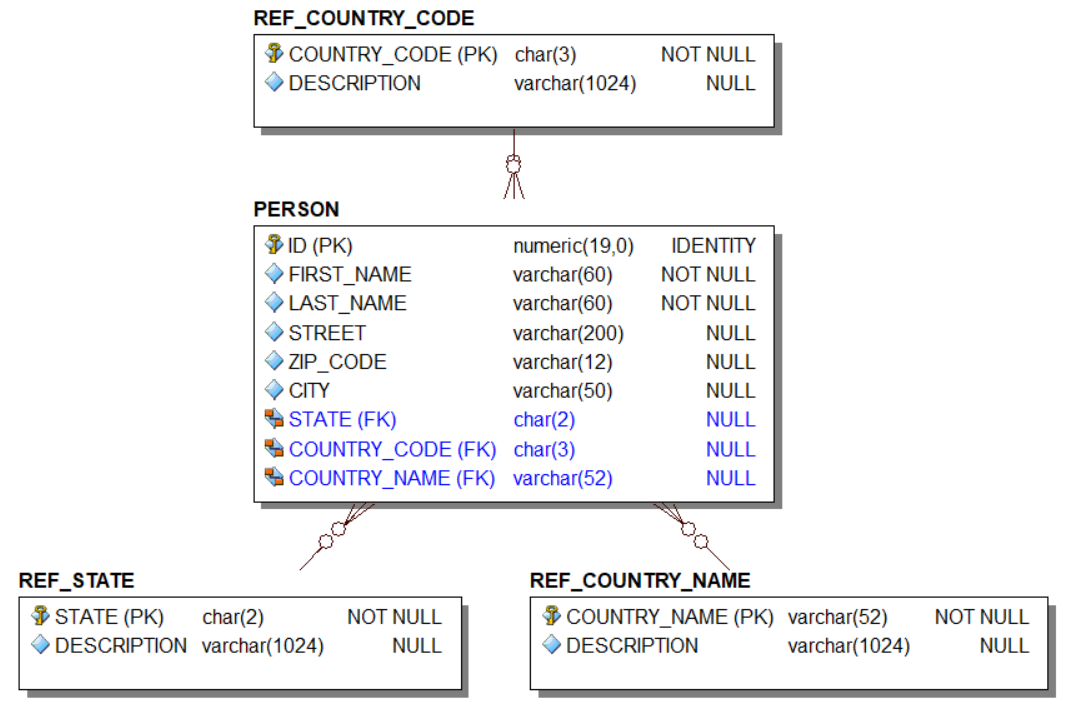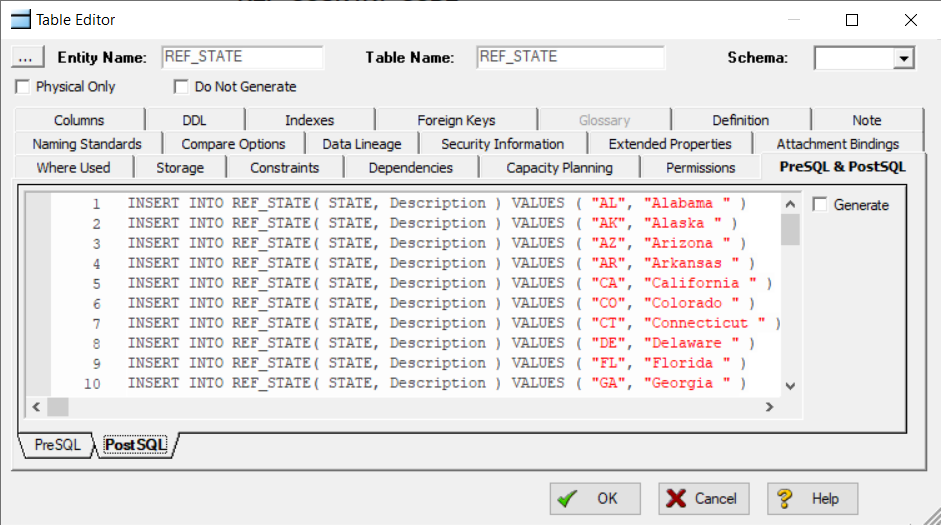With ER/Studio Data Architect, we can use the Data Dictionaries to define Reference Values and to bind them to our Attributes|Columns.
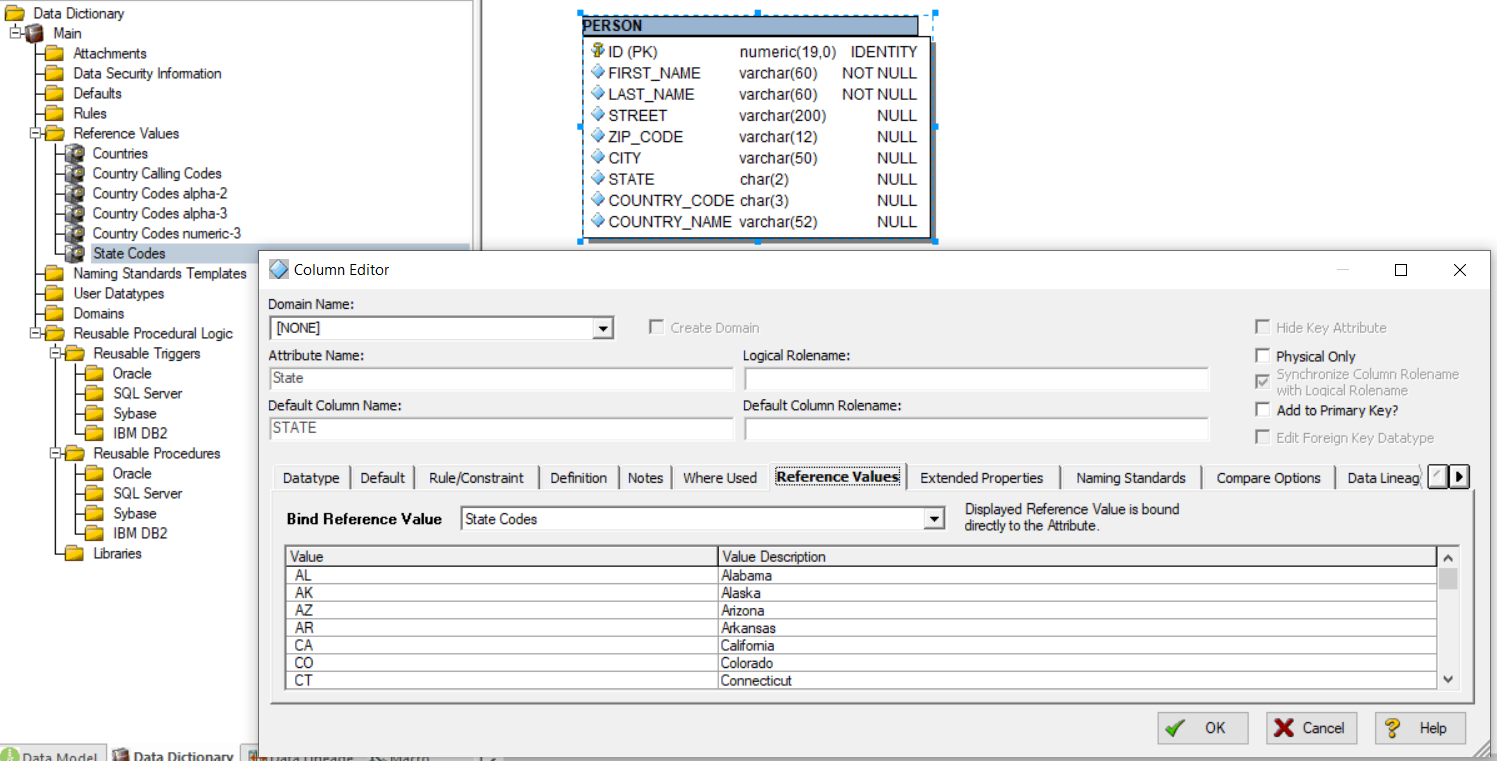
Reference Values
If we generate a JSON instance, we can directly use these Reference Values in our JSON Schema:
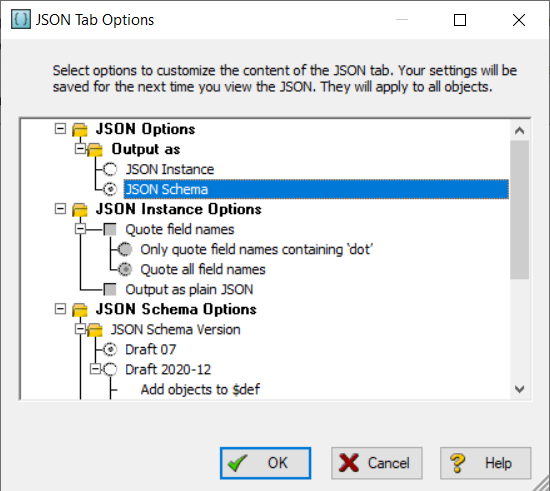
JSON Tab Options
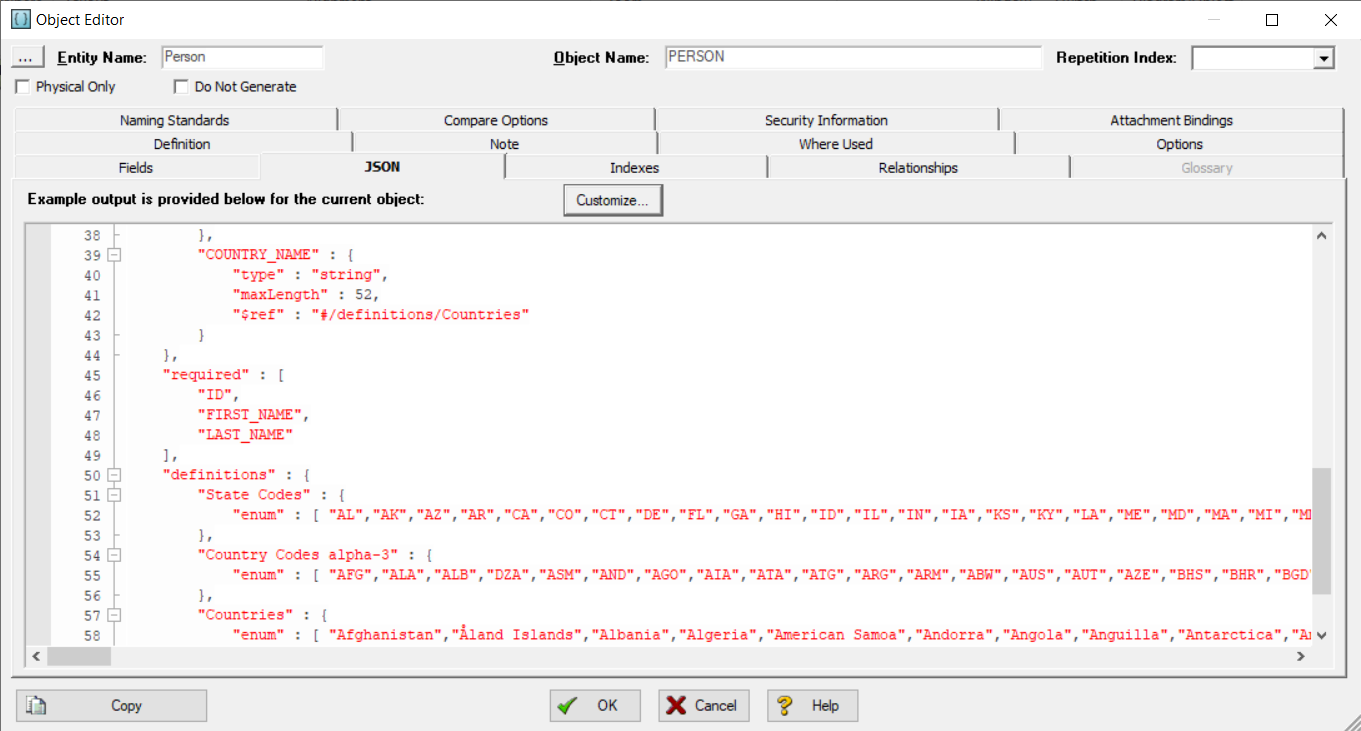
JSON Schema
Moreover, we can used it as documentation with the Tables, or we can generate objects and SQL from these Reference Values.

Report
For instance, I’ll share a script to generate the lookup tables for all the columns of the selected Tables which use Reference Values Lists. With Physical Data Model, it also generates in the Post SQL tab of the created Reference table, the Insert statements.
Usage
- Select the Entities|Tables which contain Attributes|Columns which use Reference Values
- Run the macro
- It generates one entity|table per attribute|column using a Reference Values List
- It generates the 2 attributes|columns for the lookup entity|table
Reference tables
- It generates the INSERT statements for each list item for a Physical Data Model
INSERT statements
As usual, feel free to update the code to get your custom requirements.
Script
'#Language "WWB-COM" ' 'MACRO TITLE: Generate Lookup Table From Reference Values ' 'This macro generates a lookup Table|Entity for the ' columns|attributes which use a list of Reference Values, ' for the selected table|entities. 'With Physical models, it also generates the Insert statements ' for the values in the 'Post SQL' Table Tab. ' ' Known limitations: ' The SQL code for the Insert should be updated depending on the DB ' platform used ' '------------------------------------------------------------------- Option Explicit Const REF_OBJECT_PREFIX$ = "REF_" Const GENERATE_INSERT As Boolean = True Sub Main Dim MyDiagram As Diagram Dim MyModel As Model Dim MyEntity As Entity Dim MyEntityDisplay As EntityDisplay Dim MySubModel As SubModel Dim MySelObject As SelectedObject Dim MyAttribute As AttributeObj Dim MyReferenceValue As ReferenceValue Dim MyRefEntity As Entity Dim MyRefID As AttributeObj Dim MyRefDesc As AttributeObj Dim MyRelationship As Relationship Dim MyDomain As Domain Dim MyDictionary As Dictionary Dim ID%, iExtract% Dim Logical As Boolean Dim ObjectName$, SubObjectName$ Dim ObjType%, RefValueID% Dim vp As ValuePair Dim sPostSQL$ Dim bGenerateInsert As Boolean Debug.Clear 'Get the current diagram. Set MyDiagram = DiagramManager.ActiveDiagram 'Get the current model. Set MyModel = MyDiagram.ActiveModel 'Get the current submodel. Set MySubModel = MyModel.ActiveSubModel 'Determine if the model is logical or physical. Logical = MyModel.Logical bGenerateInsert = GENERATE_INSERT And Not Logical 'Iterate through all the selected entities in the submodel For Each MySelObject In MySubModel.SelectedObjects 'Get type of the selected object. ObjType = MySelObject.Type 'We only want to get the entities, so check the object type. If ObjType = 1 Then 'Get the ID of the selected object. ID = MySelObject.ID 'Now, get the actual entity object with this ID. Set MyEntity = MyModel.Entities.Item(ID) 'If the model is logical, get the entity name. 'If it is physical, get the table name. ObjectName = IIf(Logical, MyEntity.EntityName, MyEntity.TableName) 'Now, get the actual entity display object with the name of the Entity. Set MyEntityDisplay = MySubModel.EntityDisplays.Item(ObjectName) Debug.Print ObjectName ' Loop the Attributes For Each MyAttribute In MyEntity.Attributes 'If the model is logical, get the attribute name. 'If it is physical, get the column name. SubObjectName = IIf(Logical, MyAttribute.AttributeName, MyAttribute.ColumnName) Debug.Print vbTab & SubObjectName & ": " & MyAttribute.ReferenceValueId & " / " & MyAttribute.DomainId ' Only check the attributes which are not FK yet If Not MyAttribute.ForeignKey Then ' Check if a domain is bound if no ref value set If MyAttribute.ReferenceValueId = 0 And MyAttribute.DomainId > 0 Then ' Try to get a reference to the Domain from the LOCAL DD Set MyDomain = MyDiagram.Dictionary.Domains.Item(MyAttribute.DomainId) ' Check if domain exists If Not MyDomain Is Nothing Then Debug.Print vbTab & vbTab & "Local dictionary: " & MyDomain.ReferenceValueId ' Copy the ReferenceValueId from the Domain to the Attribute|Column MyAttribute.ReferenceValueId = MyDomain.ReferenceValueId Else ' Loop the Enterprise DD For Each MyDictionary In MyDiagram.EnterpriseDataDictionaries ' Try to get a reference to the Domain from an Enterprise DD Set MyDomain = MyDictionary.Domains.Item(MyAttribute.DomainId) ' Check if domain exists If Not MyDomain Is Nothing Then Debug.Print vbTab & vbTab & "Enterprise dictionary [" & MyDictionary.Name & "]: " & MyDomain.ReferenceValueId ' Copy the ReferenceValueId from the Domain to the Attribute|Column MyAttribute.ReferenceValueId = MyDomain.ReferenceValueId ' Break the loop Exit For End If Next MyDictionary End If End If ' Check if a Reference Value is bound to the Attribute If MyAttribute.ReferenceValueId > 0 Then sPostSQL = "" ' Get the ReferenceValue Set MyReferenceValue = MyAttribute.GetReferenceValue RefValueID = MyAttribute.ReferenceValueId If Not MyReferenceValue Is Nothing Then ' Check if the ReferenceValueId is linked to a list If Not MyReferenceValue.IsRange Then ' Check if a Lookup object already exists Set MyRefEntity = MyModel.Entities(REF_OBJECT_PREFIX + SubObjectName) If MyRefEntity Is Nothing Then ' Create the Lookup object Set MyRefEntity = MyModel.Entities.AddEx(MyEntityDisplay.HorizontalPosition + 50, MyEntityDisplay.VerticalPosition) MyRefEntity.EntityName = REF_OBJECT_PREFIX + SubObjectName MyRefEntity.TableName = MyRefEntity.EntityName MyRefEntity.Definition = "Lookup Table for column '" & SubObjectName & "' of the Table '" & ObjectName & "'" MyRefEntity.Note = IIf(bGenerateInsert, "Values", "Extract") & " of the Reference Value '" & MyReferenceValue.Name & "': " & vbCrLf iExtract = 0 For Each vp In MyReferenceValue.Values Debug.Print Chr(9) & Chr(9) & vp.Value Debug.Print Chr(9) & Chr(9) & vp.ValueDescription MyRefEntity.Note = MyRefEntity.Note & vbCrLf & vp.Value & ": " & vp.ValueDescription ' Generate Insert If bGenerateInsert Then sPostSQL = sPostSQL & "INSERT INTO " & MyRefEntity.TableName & "( " & SubObjectName & ", Description ) VALUES ( """ & vp.Value & """, """ & vp.ValueDescription & """ )" & vbCrLf End If ' We only take the 5 firsts iExtract = iExtract + 1 If Not bGenerateInsert And (iExtract = 5) Then MyRefEntity.Note = MyRefEntity.Note & vbCrLf & "..." Exit For End If Next vp ' Add INSERT into the PostSQL of the lookup table If bGenerateInsert Then MyRefEntity.PostSQL = sPostSQL MyRefEntity.GenPostSQL = False End If ' Add the Reference value column Set MyRefID = MyRefEntity.Attributes.Add(SubObjectName, True) MyRefID.Datatype = MyAttribute.Datatype MyRefID.DataLength = MyAttribute.DataLength MyRefID.DataScale = MyAttribute.DataScale ' add the Description column Set MyRefDesc = MyRefEntity.Attributes.Add("Description", False) MyRefDesc.Datatype = "VARCHAR" MyRefDesc.DataLength = 1024 MyRefDesc.NullOption = "NULL" ' Add the relationship Set MyRelationship = MyModel.Relationships.Add(MyRefEntity.EntityName, ObjectName, IIf(MyAttribute.NullOption = "NOT NULL", 1, 3)) MyAttribute.ReferenceValueId = RefValueID Else Debug.Print REF_OBJECT_PREFIX + SubObjectName & " already exists!" ' Get the Reference value column Set MyRefID = MyRefEntity.Attributes.Item(SubObjectName) ' Check if the Attribute|Column exists If Not MyRefID Is Nothing Then ' Add the relationship Set MyRelationship = MyModel.Relationships.Add(MyRefEntity.EntityName, ObjectName, IIf(MyAttribute.NullOption = "NOT NULL", 1, 3)) MyAttribute.ReferenceValueId = RefValueID ' Update the Definition of the lookup object MyRefEntity.Definition = "Lookup Table for column '" & SubObjectName & "' of the Table '" & ObjectName & "'" & vbCrLf & vbCrLf & MyRefEntity.Definition End If End If End If End If End If End If Next MyAttribute End If Next MySelObject Debug.Print "" Debug.Print "End!" MsgBox "Done.", vbInformation End Sub
Bonus
A short video which shows how to create a macro from a script in ER/Studio Data Architect:
